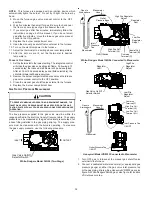
26
XI. ELECTRICAL CONNECTIONS
HIGH VOLTAGE!
T
O
AVOID
THE
RISK
OF
ELECTRICAL
SHOCK
,
WIRING
TO
THE
UNIT
MUST
BE
POLARIZED
AND
GROUNDED
.
WARNING
HIGH VOLTAGE!
T
O
AVOID
PERSONAL
INJURY
OR
DEATH
DUE
TO
ELECTRICAL
SHOCK
,
DISCONNECT
ELECTRICAL
POWER
BEFORE
SERVICING
OR
CHANGING
ANY
ELECTRICAL
WIRING
.
WARNING
L
ABEL
ALL
WIRES
PRIOR
TO
DISCONNECTION
WHEN
SERVICING
CONTROLS
. W
IRING
ERRORS
CAN
CAUSE
IMPROPER
AND
DANGEROUS
OPERATION
. V
ERIFY
PROPER
OPERATION
AFTER
SERVICING
.
CAUTION
W
IRING
H
ARNESS
The wiring harness is an integral part of this furnace. Field alter-
ation to comply with electrical codes should not be required. Wires
are color coded for identification purposes. Refer to the wiring
diagram for wire routings. If any of the original wire as supplied
with the furnace must be replaced, it must be replaced with wiring
material having a temperature rating of at least 105°C. Any re-
placement wiring must be copper conductor.
115 V
OLT
L
INE
C
ONNECTIONS
Before proceeding with electrical connections, ensure that the sup-
ply voltage, frequency, and phase correspond to that specified on
the unit rating plate. Power supply to the furnace must be N.E.C.
Class 1, and must comply with all applicable codes. The furnace
must be electrically grounded in accordance with local codes or, in
their absence, with the latest edition of The National Electric Code,
ANSI NFPA 70 and/or The Canadian Electric Code CSA C22.1.
Use a separate fused branch electrical circuit containing properly
sized wire, and fuse or circuit breaker. The fuse or circuit breaker
must be sized in accordance with the maximum overcurrent pro-
tection specified on the unit rating plate. An electrical disconnect
must be provided at the furnace location.
NOTE:
Line polarity must be observed when making field
connections.
Connect hot, neutral, and ground wires as shown in the wiring
diagram located on the unit’s blower door. For direct vent applica-
tions, the cabinet opening to the junction box must be sealed air
tight using either a UL approved bushing such as Heyco Liquid
Tight or by applying a UL approved non-reactive sealant to bush-
ing.
Line polarity must be observed when making field connections.
Line voltage connections can be made through either the right or left
side panel. The furnace is shipped configured for a left side (right side
for counterflows) electrical connection with the junction box located
inside the burner compartment. To make electrical connections
through the opposite side of the furnace, the junction box must be
relocated to the other side of the burner compartment prior to making
electrical connections. To relocate the junction box, observe the fol-
lowing steps.
J
UNCTION
B
OX
R
ELOCATION
E
DGES
OF
SHEET
METAL
HOLES
MAY
BE
SHARP
. U
SE
GLOVES
AS
A
PRECAUTION
WHEN
REMOVING
HOLE
PLUGS
.
WARNING
1.
Remove the burner compartment door.
2.
Remove and save the two screws securing the junction box
to the side panel.
3.
Relocate junction box and associated plugs and grommets
to opposite side panel. Secure with screws removed in
step 2.
*
*
*
*
*
*
*
*
*
STANDARD
JUNCTION BOX
LOCATION
ALTERNATE
JUNCTION BOX
LOCATION
Junction Box Relocation
HIGH VOLTAGE!
T
O
AVOID
THE
RISK
OF
INJURY
,
ELECTRICAL
SHOCK
OR
DEATH
,
THE
FURNACE
MUST
BE
ELECTRICALLY
GROUNDED
IN
ACCORDANCE
WITH
LOCAL
CODES
OR
IN
THEIR
ABSENCE
,
WITH
THE
LATEST
EDITION
OF
THE
N
ATIONAL
E
LECTRIC
C
ODE
.
WARNING
To ensure proper unit grounding, the ground wire should run from
the furnace ground screw located inside the furnace junction box
all the way back to the electrical panel.
NOTE:
Do not use gas
piping as an electrical ground. To confirm proper unit grounding,
turn off the electrical power and perform the following check.
1.
Measure resistance between the neutral (white) connection
and one of the burners.
2.
Resistance should measure 10 ohms or less. This furnace
is equipped with a blower door interlock switch which
interrupts unit voltage when the blower door is opened for
servicing. Do not defeat this switch.









































